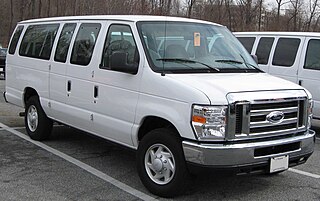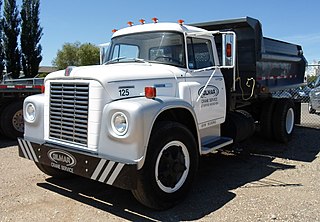
The Ford E-Series, also branded the Ford Econoline or Ford Club Wagon, is a range of full-size vans manufactured and marketed by the Ford Motor Company. Introduced for model year 1961 as the replacement for the Ford F-Series panel van, the E-Series line is currently in its fourth generation.

The Ford F-Series is a series of light-duty trucks marketed and manufactured by Ford since the 1948 model year. Slotted above the Ford Ranger in the Ford truck model range, the F-Series is marketed as a range of full-sized pickup trucks. Alongside the F-150, the F-Series also includes the Super Duty series, which includes the heavier-duty F-250 through F-450 pickups, F-450/F-550 chassis cabs, and F-600/F-650/F-750 Class 6-8 commercial trucks. The most popular version of the model line is the F-150 pickup truck, currently in its 14th generation. From 1953 to 1985, the entry-level F-series pickup was the ½ ton F-100.

The International Harvester Company was an American manufacturer of agricultural and construction equipment, automobiles, commercial trucks, lawn and garden products, household equipment, and more. It was formed from the 1902 merger of McCormick Harvesting Machine Company and Deering Harvester Company and three smaller manufactures: Milwaukee; Plano; and Warder, Bushnell, and Glessner. In the 1980s all divisions were sold off except for International Trucks, which changed its parent company name to Navistar International. Its brands included McCormick, Deering, and later McCormick-Deering, as well as International. Along with the Farmall and Cub Cadet tractors, International was also known for the Scout and Travelall vehicle nameplates.

The Chevrolet Kodiak and GMC TopKick are a range of medium duty trucks that were produced by the Chevrolet and GMC divisions of General Motors from 1980 to 2009. Introduced as a variant of the medium-duty C/K truck line, three generations were produced. Slotted between the C/K trucks and the GMC Brigadier Class 8 conventional, the Kodiak/TopKick were developed as a basis for vocationally-oriented trucks, including cargo haulers, dump trucks, and similar vehicles; on later generations, both cutaway and cowled-chassis variants were produced for bus use.

The International Harvester Travelall is a model line of vehicles that were manufactured by International Harvester; four generations were produced from 1953 to 1975. Derived from the International light truck line, the Travelall was a truck-based station wagon. One of the first competitors to the Chevrolet Suburban, the Travelall was a forerunner of modern people carriers and full-size sport utility vehicles.

The medium-duty version of the Ford F-Series is a range of commercial trucks manufactured by Ford since 1948. Derived from the smaller F-Series pickup trucks, the medium-duty range is currently in its eighth generation. Initially slotted between the F-Series pickup trucks and the "Big Job" conventionals, later generations were slotted below the L-Series "Louisville" trucks; the last two generations are the largest vehicles produced by Ford since its exit from the heavy-truck segment.

The International L series was introduced by International Harvester in fall 1949 as the replacement for the KB series and were available as everything from light pickup trucks and delivery vehicles to full-size tractor-trailers. Electric wipers, a radio, and a clock were optional. International would continue to produce the line until 1952 when it was replaced by the R series.

The International TranStar, is a range of Class 8 trucks produced by Navistar International for North America. Produced nearly exclusively as a semitractor, the product range is focused towards local delivery and regional shipping.

The Ford L-series is a range of heavy-duty trucks that were assembled and marketed by Ford between 1970 and 1998. Ford had been producing their "Heavy Duty" trucks since 1948 and their "Super Duty" lineup since 1958 marketed by various GVW ratings. Truck weight classifications 1-8 were a new concept brought about by the DOT National Highway Administration. The first dedicated Class 8 truck produced by the company, the L-series range replaced the F-series "Super Duty" and N-series. Produced as both straight trucks and semitractors, the Ford L-series encompassed a wide range of models through the Class 6-8 GVWR ratings in medium-duty, severe-service, and vocational applications. The line would become one of the most popular series of trucks Ford ever produced.

The International Loadstar is a series of trucks that were produced by International Harvester from 1962 to 1978. The first product line of the company developed specifically as a medium-duty truck, the Loadstar was slotted between C-Line pickup trucks and the heavy-duty R-series. Following the discontinuation of the R-series, the Loadstar was slotted below the Fleetstar and Transtar conventionals.

The International S series is a range of trucks that was manufactured by International Harvester from 1977 to 2001. Introduced to consolidate the medium-duty IHC Loadstar and heavy-duty IHC Fleetstar into a single product range, the S series was slotted below the Transtar and Paystar Class 8 conventionals.
The bus chassis variant of the International S series is a cowled bus chassis that was produced by International Harvester from 1979 to 2001. Produced primarily for school bus applications, the chassis was also produced for other applications, including commercial-use buses and cutaway-cab buses. In addition, the cowled chassis formed the basis for front-engine and rear-engine stripped chassis produced for bus applications.

The Ford B series is a bus chassis that was manufactured by the Ford Motor Company. Produced across six generations from 1948 to 1998, the B series was a variant of the medium-duty Ford F series. As a cowled-chassis design, the B series was a bare chassis aft of the firewall, intended for bodywork from a second-stage manufacturer. While primarily used for school bus applications in the United States and Canada, the chassis was exported worldwide to manufacturers to construct bus bodies for various uses.

The International 9000 Series is a range of trucks that was manufactured by Navistar International. Introduced as the Transtar 4000 in 1971, the model line was produced across three generations until 2017; following the incorporation of Navistar, the Transtar was rebranded as the 9000 series. Slotted below the Paystar range, the 9000 series was a conventional-cab truck configured primarily for highway applications.

The International Fleetstar is a series of trucks that was produced between 1962 and 1977 by International Harvester. Slotted above the Loadstar and below the Paystar and Transtar conventionals introduced after it, the Fleetstar was a heavy-duty truck; it was one of the first designed for vocational use. Using a conventional-cab configuration, the Fleetstar was available as both a straight truck and as a semitractor, with both single and tandem rear axles.

The seventh generation of the Ford F-Series is a range of trucks that was produced by Ford from the 1980 to 1986 model years. The first complete redesign of the F-Series since the 1965 model year, the seventh generation received a completely new chassis and body, distinguished by flatter body panels and a squarer grille. This generation marked several firsts for the model line, including the introduction of the Ford Blue Oval grille emblem, the introduction of a diesel engine to the model line, and a dashboard with a full set of instruments (optional). Conversely, this generation marked the end of the long-running F-100, the Ranger trim, and sealed-beam headlamps. This was also be the final generation of the F-Series produced with the traditional Flareside bed, using separate rear fenders and taillamps, steel sides, and an (optional) wooden floor.

The International Light Line pickups replaced the C-Series as International's Light Line range of pickup trucks in early 1969, for a shortened model year. The name started out as a simple continuation of the previous A-, B-, and C-series trucks. It was largely a rebodied version of its predecessors, with a square-rigged look very similar to the period Scout utility vehicle. The Travelall underwent parallel changes to the Light Line trucks. The light line of trucks was marked by a larger range of transmission and wheelbase options than any of its competitors, and in general the lineup aimed to maximize adaptability. The Light Line was also available as a bare chassis, for special purpose applications. Production ended partly replaced by new Scout Terra in late April 1975, as a hard-pressed International chose to focus on the Scout and on heavier machinery.
The International C series and its succeeding models is a series of pickup trucks that were built by International Harvester from 1961 to 1968. They succeeded the earlier B-series range.

The second generation of the C/K series is a range of trucks that was manufactured by General Motors. Marketed by both the Chevrolet and GMC divisions from the 1967 to 1972 model years, this generation was given the "Action Line" moniker by General Motors. As with its predecessor, the second generation C/K included full-size pickup trucks, chassis cab trucks, and medium-duty commercial trucks.





















